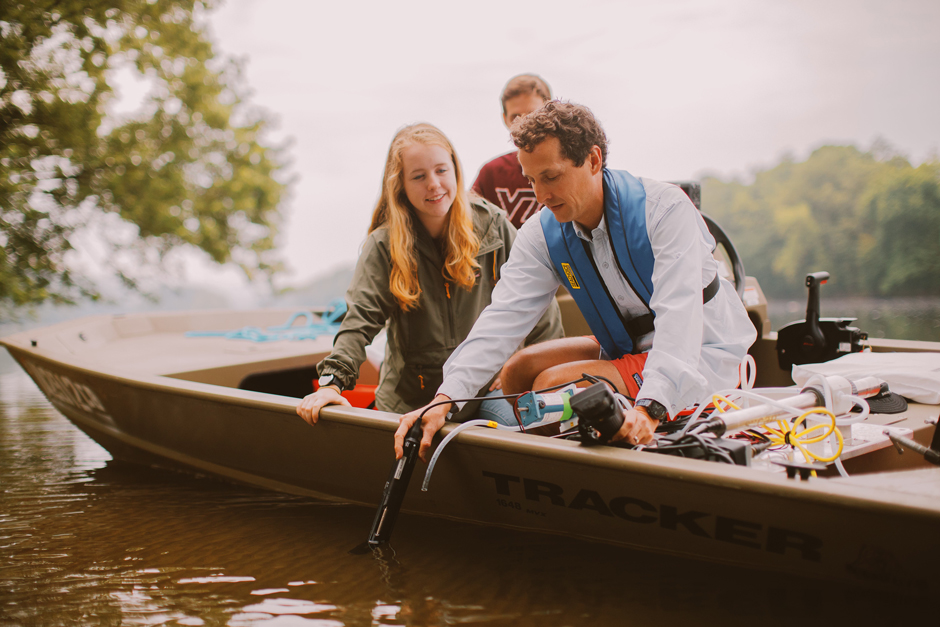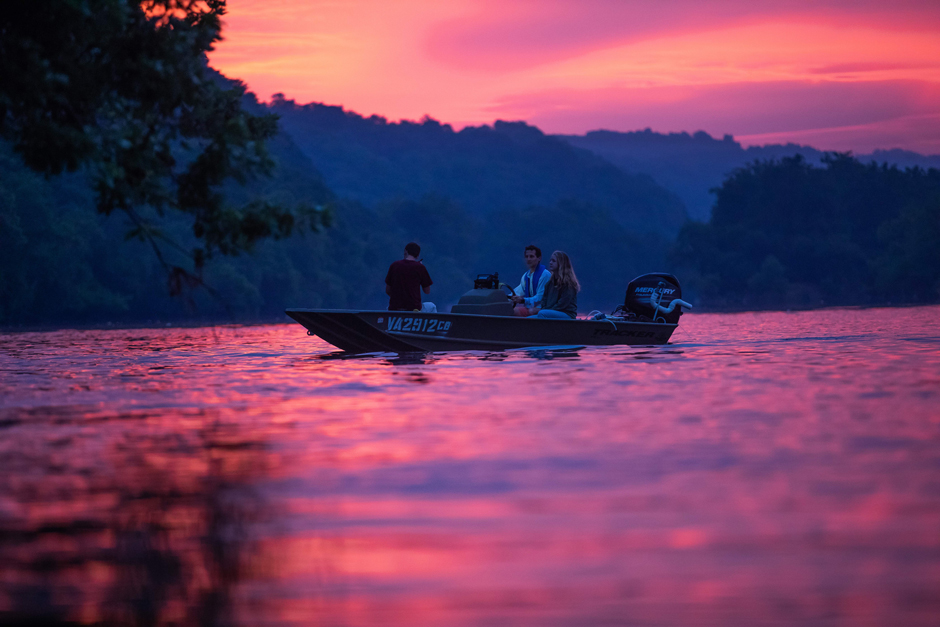The Water of Life: How Understanding Natural Hydrologic Processes in Aquatic Ecosystems Can Lead to a Sustainable Future
 Monitoring for nitrate, DO, and conductivity along the New River (Credit: Sam Dean)
Monitoring for nitrate, DO, and conductivity along the New River (Credit: Sam Dean)From watersheds that provide drinking water, the rain that nourishes plants, to the streams and rivers that help aquatic ecosystems flourish, water is an ever-present and ever-essential part of life. For those like Durelle Scott, a professor of Biological Systems Engineering at Virginia Tech University, understanding the importance of these natural systems was always a part of life.
The desire to preserve the nation’s aquatic resources stems from a childhood spent exploring the lakes and streams that surrounded him growing up in rural Pennsylvania. Now, as a teacher and a researcher, Scott makes it a priority to ensure that people now and in the future appreciate the enormous impact that aquatic ecosystems have on their lives.
“I would say that water connects us all. We all live downstream,” remarks Scott. “What’s in that water becomes really relevant to you and I as individuals and our human health, as well as how much taxpayer dollars are needed to clean that water up.”
Hazards and contaminants in aquatic ecosystems pose a huge risk to humans and the ecological system, and Scott is searching for ways to improve their health.
Searching for New Solutions
As humans continue to live, build and farm on new land, the systems and structures of that land change and the natural processes that once fueled the ecosystem are altered. Engineers have devised methods of controlling water flow and distribution, such as levees and dams, but these developments can add to land use pressure. In an effort to not only control water but also to promote sustainability, engineers have turned to “nature-based solutions.”
In considering nature-based solutions, Scott states, “How can we harness the potential of biology? Exploring nature-based solutions has enormous potential to maximize human well-being and ecosystems.”
In the floodplains that surround rivers, farmland has directed water away from supplying the river itself—instead being harnessed for irrigation and agriculture. Not only does this diminish the healthy supply of water and nutrients into a river, but the water that may eventually make its way downstream has the potential to be contaminated by chemicals used in fertilizers, pesticides and petroleum products that enter waterways via runoff. Runoff itself is caused by storms, irrigation and other disturbances to the landscape.
When so much has been built and altered across a landscape, sacrifices must be made to improve water quality downstream. Scott gives the example of reconnecting streams to rivers with the goal of improving the health and function of floodplains. “Getting water back out onto a floodplain not only increases ecosystem services but also reduces land for farming. So there are cons but at the same time, it’s good for ecosystem services, such as reducing flooding for downstream communities. There are always compromises.”
Responding to a Changing Climate
It is within aquatic ecosystems that some of the most tangible effects of anthropogenic pollution and climate change can be observed. Algal blooms in Lake Erie and rivers have rendered areas unsuitable for recreational activities such as swimming and fishing. Scott added that across the world, rivers such as the Mekong River in Southeast Asia and the Amazon supply those living on them with their main food sources. Therefore, if areas upstream are suddenly contaminated, then people’s immediate health and livelihood could be at risk.
Scott explains, “As we go through extended droughts or a very large, catastrophic flood, both disrupt the floodplain biodiversity and some of those services that we collectively all rely on.” Understanding how material flows through aquatic ecosystems is important in understanding how it affects the plants, animals and humans who rely on it. This is why Scott and his students are continually learning more about these systems and devising solutions that will benefit both human and ecosystem health as society adapts to the changing climate.

Dr. Durelle Scott and two of his students on the New River in Blacksburg, Virginia. (Credit: Sam Dean)
Public Outreach
Generating public interest and understanding water as a resource and a place to protect is an important step toward water sustainability. The goal of water sustainability ensures that water quality remains at or becomes a level safe for humans and the surrounding ecosystem in the future. “It’s something not only just to protect, but it’s valuable to us,” says Scott. “If we didn’t have the natural filtration that occurs in a floodplain or stream channel, we would be spending a lot more money on water treatment.”
Tuning the public into why scientists do what they do can be hugely beneficial in garnering support for research and projects. “Use data to help tell the story and understand what’s going on, then share that with people,” explains Scott.
The students at Virginia Tech have proved to be an inspiration as well. Getting students involved in his research, doing their own and inspiring them to carry the same values and appreciation of hydrology into their careers has been hugely rewarding, says Scott. “I would say that the best part of my job is working with students,” he explains. “Then seeing that light bulb moment turn on for the student is just simply fun.”
Another rewarding aspect of his work at Virginia Tech is seeing his, and his students’ discoveries show up in the state legislature. Scott has worked with the Virginia Department of Environmental Quality and the Office of Water Supply, as well as seen his work appear in the State Water Resources plan. Scott remarked on how exciting it has been, restoration-wise, to see the work that he and his students have done in floodplains, and further noted how tangible results can provide great encouragement for future projects.
On campus in Blacksburg, Virginia, students and faculty alike can see the results of a stream restoration project. The StREAM Lab, led by Dr. Cully Hession, a professor in Biological Systems Engineering at Virginia Tech, allows students to participate in hands-on fieldwork near their homes and see the results with their own eyes.
Along with the classes being taught, Scott and his team of students have been able to conduct research in Stroubles Creek, where the StREAM Lab is located. Scott explains, “It’s exciting to see both the change that has occurred over the last decade, but [also] how that’s really galvanized a future generation of students to seeing the benefits of restoration.”
Conclusion
Preserving watersheds and other natural systems is crucial to ensuring water sustainability in the future–but that is only half the battle. Equipping students with the tools to be future conservationists and innovators, as well as helping the public understand the importance of quality hydrological research and applications, will help lead to the greatest change within these valuable aquatic ecosystems.
Encouraging those around him to see the small victories has helped Scott garner enthusiasm from his students and colleagues.
“How do I share that the 1970s Clean Water Act has made an incredible difference? The small success stories that are happening with some of the sustainable development goals that the UN has, or different stories that help show that each of us can push and make a difference.” Scott points out. “I think that’s that one of my biggest proactive measures right now: to inspire hope.”




Sara
March 15, 2023 at 8:42 am
Looking at the changing climate, understanding about natural hydrologic processes in aquatic ecosystems definitely seems like a step in the right direction. Thanks a lot for sharing the post.